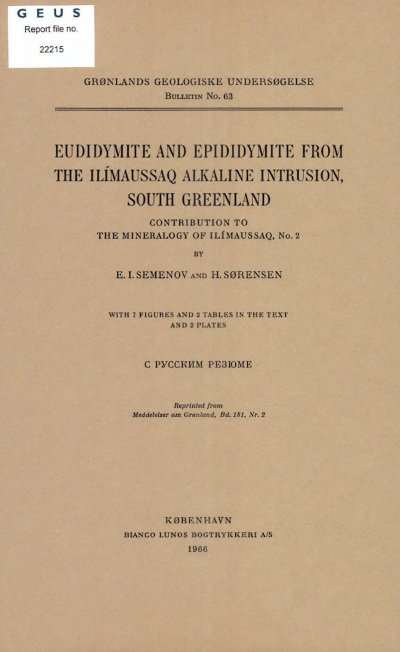Eudidymite and epididymite from the Ilímaussaq alkaline intrusion, South Greenland
DOI:
https://doi.org/10.34194/bullggu.v63.6597Abstract
Eudidymite has been discovered as lamellar or spherulitic aggregates in veins of albitite in alkali granite and in poikilitic nepheline-sodalite syenite (naujaite) in the Ilímaussaq alkaline intrusion, South Greenland. In the veins in granite it is associated with microcline, quartz, albite, arfvedsonite, ægirine, polylithionite, narsarsukite, monazite and elpidite. In naujaite eudidymite is associated with albite, microcline, fluorite, analcime, tugtupite, epididymite, genthelvite, neptunite, schizolite, lithium mica, ægirine, katapleiite, etc. Epididymite occurs as microcrystalline or fine-grained masses associated with analcime, albite, tugtupite, eudidymite leucophane, schizolite, etc. in veins of albitite in naujaite. The optical properties of the two minerals are: eudidymite: nα = 1.545, nγ = 1.549, 2 Vγ = 25°; epididymite: nα = 1.540, nγ = 1.544, 2 Vα = 16-26° with a pronounced crossed axial plane dispersion. Both minerals are polysynthetically twinned. Chemical analyses of the two minerals are recorded. The X-ray powder diagrams are identical with those of epididymite and eudidymite from Lovozero. Eudidymite and epididymite were formed during late albitization of naujaite. Their mode of occurrence recalls that of these two minerals at Lovozero, the Kola peninsula.
Downloads
Published
How to Cite
Issue
Section
License
This article is distributed under a CC-BY 4.0 licence, permitting free redistribution and reproduction for any purpose, even commercial, provided proper citation of the original work. Author(s) retain copyright over the article contents.


